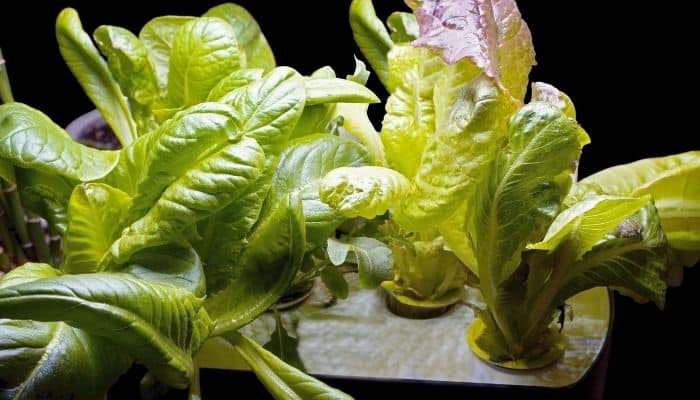Lettuce is known for being one of the simplest vegetables to grow worldwide. Regardless of whether you savor salads or sandwiches, you likely indulge in lettuce in a plethora of recipes.
Many of us have tried to grow lettuce at home using traditional methods with varying degrees of success.
Like me, you’ve probably found that growing lettuce in dirt often comes with problems, such as slugs and a gritty feeling in your mouth if it’s not washed impeccably.
That’s where the beauty of growing plants in water shines, but what about lettuce? Can it be done, and is it easy?
Can you grow lettuce with aquaponics? Lettuce can definitely be grown via aquaponics and is one of the very best plants of all to cultivate in aquaponic systems. It grows fast, takes little effort and monitoring, and many varieties are the cut-and-come-again type. Loose-leaf, butterhead, and romaine are three of the most popular.
In the following, you’ll find the jump start you need for success in growing lettuce using aquaponics.
What Lettuce Varieties Are Best for Growing Aquaponically?
Just about any sort of lettuce grows well in aquaponics. That said, there are three types of lettuce varieties that are better than the rest.
Loose-Leaf Lettuce
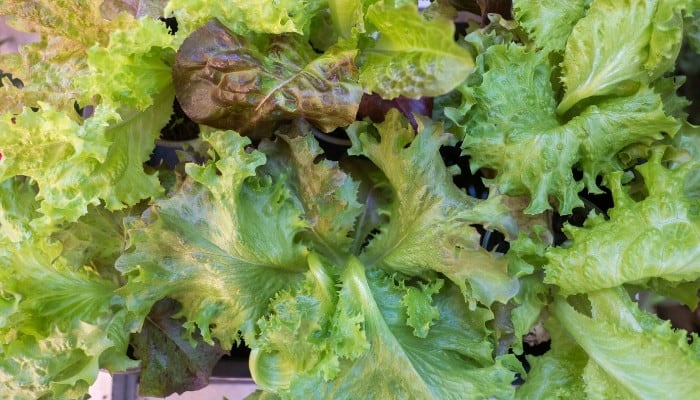
One of the most common and simple types of lettuce is the loose-leaf variety.
Loose-leaf lettuce adjusts to changes in water temperatures better than most, grows fast, and has a wide range of subspecies.
A major difference between loose-leaf and other lettuce is that it doesn’t form “heads.”
Butterhead Lettuce
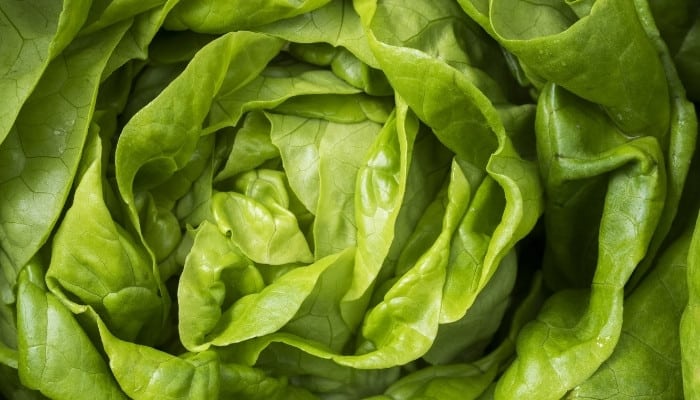
Named for its soft and buttery leaves, butterhead lettuce is another great option for aquaponics.
It is just as hardy as loose-leaf and also has several subspecies. It grows very quickly, tastes sweet and mild, and has a good market value.
Romaine Lettuce
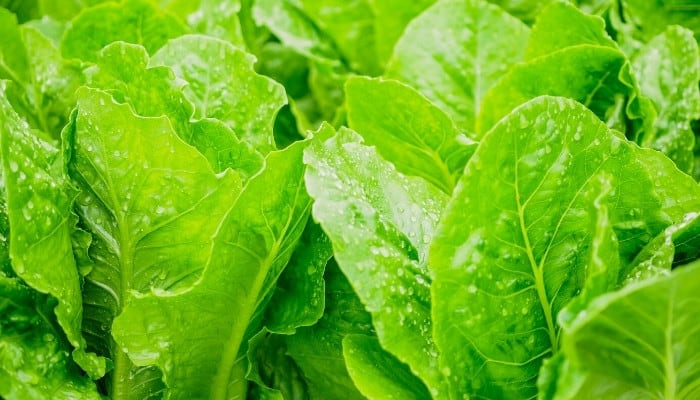
One of the most sturdy types of lettuce to grow in an aquaponic system is the romaine variety.
These types of lettuce are typically taller, thicker, and much more resistant to temperature changes. The heads and hearts of romaine lettuce are highly marketable.
Is Lettuce Good for Aquaponics?
Lettuce is not just good for aquaponics, it’s one of the very best crops to grow aquaponically.
There are several reasons why, but two stand out among the others:
Lettuce isn’t as sensitive to water temperatures as other plants, and it grows extremely fast.
Pros:
- Lettuce does very well in the average aquaponic system’s water temperature, which is around 69 to 74℉.
- Even if your water temperature varies, lettuce isn’t bothered by a bit of fluctuation in water temps.
- Lettuce grows very quickly by nature, and it grows twice as fast in aquaponics.
- Most lettuce species are super-low maintenance, making them one of the easiest crops to grow in an aquaponic system.
Cons:
- Lettuce may not bring as much market value as other plants.
- If affected by root rot or some other disease, lettuce plants aren’t worth “saving.”
- Need replanting quite frequently (because they grow so fast).
Overall Difficulty
In terms of difficulty, lettuce is one of the easiest types of vegetables to grow with aquaponics.
They take very little effort on your part after planting, and harvesting is quick and simple.
Things To Consider
Depending on your local market or personal preferences, there are numerous lettuce species frow, which to choose.
In fact, deciding which sort of lettuce to grow in your aquaponic system may be the hardest aspect of growing aquaponic lettuce.
How Do You Start Lettuce Seeds for Aquaponics?
Starting lettuce seeds for aquaponics is as easy as 1-2-3, literally.
- Place 3 to 5 seeds in a starter medium like rockwool cubes, peat pellets, or plugs.
- Stick the cubes, pellets, or plugs into a growing tray, plate, or bowl, water them, and place the container in the dark.
- Mist the seeds/growing medium once per day for up to 2 weeks.
After approximately 10 to 15 days pass, the seeds will be sprouted and ready for transferring into your aquaponic growing system.
Alternatively, you could start your seeds in grow sponges. Learn the basics to this easy method here.
Growing Time: How Long Does Lettuce Take?
Lettuce isn’t just one of the fastest-growing vegetables for aquaponics, it’s among the fastest-growing vegetables in the world, period.
Most leafy types of lettuce grow in approximately 30 days. Hardier and “head” types of lettuce, however, may require between 45 and 60 days.
Keep in mind that depending on your specific aquaponic setup, lettuce may grow two to three times as fast as it does traditionally.
That means that you could grow mature lettuce as fast as just two weeks.
Fastest Varieties of Lettuce
- Coastline summer crisp lettuce – 30 days
- Flashy butter oak lettuce – 30 days
- Ithaca iceberg lettuce – 30 days
- New red fire loose-leaf lettuce – 30 days
- Ice green loose-leaf lettuce – 30 days
- Lau’s pointed leaf romaine lettuce – 30 days
- Summer bibb butterhead lettuce – 30 days
Slower Varieties of Lettuce
- Corn salad mache lettuce – 50 days
- Parris Island romaine lettuce – 50 days
- Tennis ball bibb lettuce – 55 days
- Tom Thumb butterhead lettuce – 55 days
- Frisee endive lettuce – 65 days
- Celtuce lettuce – 75 days
Hydroponic Lettuce Grow Systems
Deep water culture, ebb and flow, nutrient film technique, and aeroponics are the most preferred types of hydroponic lettuce grow systems.
Lettuce species are water-loving plants and therefore are growable with just about every type of hydroponic system known to man.
Though they are not the most highly suggested for growing lettuce, even wick and drip systems work.
How To Grow Aquaponic Lettuce
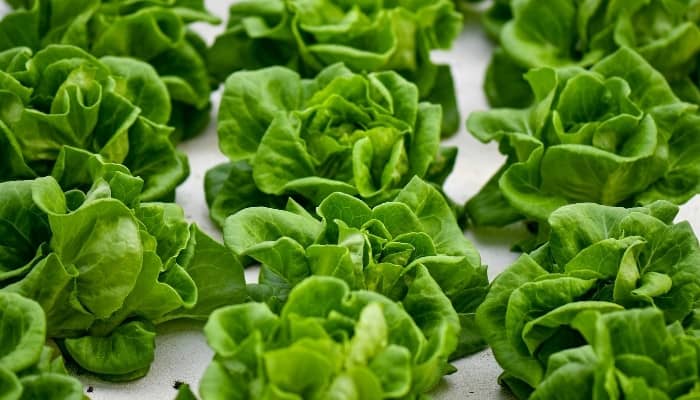
Growing aquaponic lettuce is one of the most common ventures new growers try out. The process is simple:
- Start seeds.
- Prepare grow sites with net pots and growing medium while seeds are germinating.
- Transfer seedlings to grow sites.
- Add a bit of fertilizer to the system.
- Monitor your system and tweak as needed.
- Harvest when the crop is complete.
The above-listed steps are indeed truly as simple as they seem. To get started, here’s what you need (besides an aquaponic system already set up):
- Lettuce seeds
- Net pots
- A growing medium like clay pellets or Rockwool
- Fertilizer with a ppm N of 100 to 150
Other Important Information
The best methods for growing aquaponic lettuce are without question deep water culture (for small-scale growing) and NFT (for larger operations).
The best pH level for aquaponic lettuce is 5.5 to 6.0, with an EC level of approximately 1.2.
Water temperatures should stay around 60 to 70℉, though they can survive temperatures of up to 10 degrees or so higher or lower.
Last but not least, when it comes to spacing the grow sites, there are several options.
For smaller systems, spacings of 6 to 8 inches are common. In larger setups, spacings between growing sites may range from 10 to 18 inches.
Can I Regrow Aquaponic Lettuce?
Lettuce is typically able to be regrown at least two to three times.
If you’re extremely particular about how you harvest it, you may even get four of five regrows out of lettuce.
To regrow aquaponic lettuce, simply harvest the outer parts of the plant as they grow. It’s best practice to harvest lettuce slightly before it’s fully mature, as it’s at its tastiest then.
Even if you opt to remove entire lettuce plants while harvesting, you can still regrow it by replanting the stem. However, it may not grow back as a full-size head if done this way.
Romaine lettuce is one of the best types of aquaponic lettuce to regrow, but all types of lettuce are regrowable.
When lettuce starts taking extra long to grow back, it’s time to get rid of it and replace the plant with a new one.
Likewise, when lettuce goes to bolting (growing shoots from its center loaded with seeds) it’s time to pull it and start over (unless you want to collect seeds!).
Troubleshooting Problems With Aquaponic Lettuce
Aquaponic lettuce may be one of the best plants for aquaponic systems in general, but no plant is without its problems. Lettuce is no different.
Here are a few of the most common problems with aquaponic lettuce and how to fix them.
Black or Burned Tips
Lettuce has a tendency to burn or blacken around the outer edges of its leaves when it isn’t getting enough water.
If you notice your lettuce leaf tips burning or turning black, check their roots, and adjust them as needed.
Solution
The most common fixes for black or burned lettuce tips are unclogging grow pipes, increasing water flow, or pruning the roots.
Unbalanced pH Levels
Another rather common issue with failing aquaponic lettuce is unbalanced pH levels.
If you run into this problem your lettuce will begin wilting and yellowing. They may even simply die without much warning.
Solution
To alleviate the issue, simply test the water in your system and readjust it. The best pH level for lettuce in aquaponic systems is between 5.5 and 6.0.
That said, some species may prefer a slightly higher pH level such as 6.4 or 6.5.
Environmental Issues
Lettuce is extremely hardy when grown in well-maintained aquaponic systems, but it is still prone to environmental issues just like any other plant.
If your water levels drop below 50 to 60 degrees, you may have some shell-shocked lettuce on your hands.
Likewise, if water temps rise above 70 to 80 degrees, lettuce may wilt and die quite rapidly.
Other environmental issues that affect lettuce include not enough air flow in hot temperatures and of course lack of proper lighting.
Solution
Both airflow and lighting are straightforward fixes; add ventilation to your system, and increase or decrease light exposure.
Closing Thoughts About Growing Aquaponic Lettuce
Growing aquaponic lettuce is one of the best ventures you can get your hands dirty and feet wet with, in regards to aquaponics.
Lettuce grows so fast in aquaponic systems that you can harvest it on a weekly or biweekly basis if you stagger your planting.
Furthermore, lettuce is one of the few types of plants that you can grow and regrow numerous times without restarting seeds or even taking clones.
Follow the guide above, and you’ll be growing lettuce like an aquaponics pro in no time.

